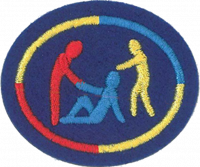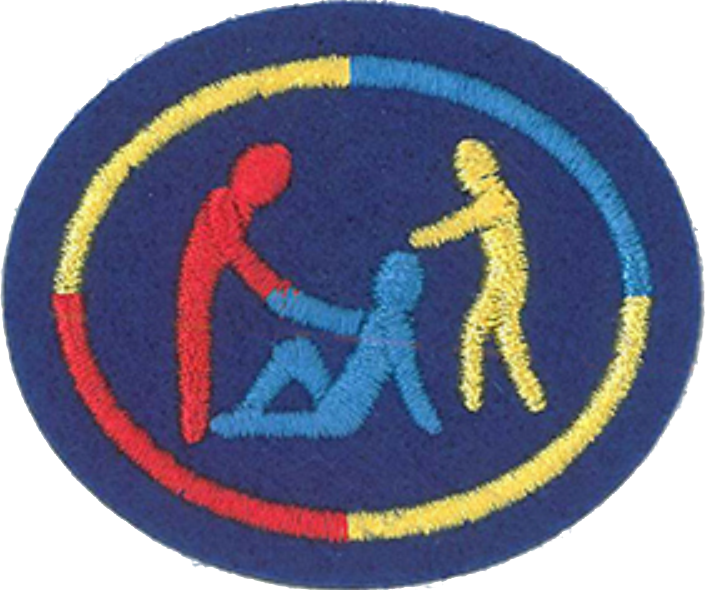Difference between revisions of "AY Honors/Bully Prevention I/Requirements/es"
(Created page with "Especialidades JA/Prevención del acoso I/Requisitos") |
(Created page with "</noinclude>Dar una definición básica del acoso. Diferenciar claramente entre el acoso y el conflicto. .<noinclude>") |
||
| Line 6: | Line 6: | ||
| − | <b><section begin=reqPrologue /><noinclude> | + | <b><section begin=reqPrologue /><noinclude></noinclude>Nota: Debido a la naturaleza sensible (y la prevalencia) del acoso, se sugiere que esta especialidad sea enseñada por una persona que haya recibido capacitación recientemente o haya realizado una lectura/investigación significativa acerca del tema de la prevención del acoso (y si es posible haya sido certificado en este tema). La MEJOR manera de desarrollar esta especialidad es a través de una serie de sesiones, de modo que los principios se conviertan en parte de la naturaleza de los participantes, en vez de que aprendan rápidamente y se olviden igual de rápido.<br>Nota: Prevención del acoso I y II se escribieron sin que uno fuera el requisito previo del otro para que el instructor pueda elegir la(s) especialidad(es) para enseñar que son más relevantes para el grupo y la dinámica de grupo. |
| − | </noinclude> | + | <noinclude></noinclude><section end=reqPrologue /></b> |
| − | <noinclude | ||
| − | |||
| − | <b>1. <section begin=req1 /><noinclude> | + | <b>1. <section begin=req1 /><noinclude></noinclude>Dar una definición básica del acoso. Diferenciar claramente entre el acoso y el conflicto. |
| − | </noinclude> | + | <noinclude></noinclude><section end=req1 /></b> |
| − | <noinclude | ||
| − | |||
| − | <b>2. <section begin=req2 /><noinclude> | + | <b>2. <section begin=req2 /><noinclude></noinclude>Describir brevemente los siguientes tipos de acoso: |
| − | </noinclude> | + | <noinclude></noinclude><section end=req2 /></b> |
| − | <noinclude | ||
| − | |||
| − | :<b>a. <section begin=req2a /><noinclude> | + | :<b>a. <section begin=req2a /><noinclude></noinclude>El acoso verbal |
| − | </noinclude> | + | <noinclude></noinclude><section end=req2a /></b> |
| − | <noinclude | ||
| − | |||
| − | :<b>b. <section begin=req2b /><noinclude> | + | :<b>b. <section begin=req2b /><noinclude></noinclude>El acoso físico |
| − | </noinclude> | + | <noinclude></noinclude><section end=req2b /></b> |
| − | <noinclude | ||
| − | |||
| − | :<b>c. <section begin=req2c /><noinclude> | + | :<b>c. <section begin=req2c /><noinclude></noinclude>El acoso prejudicial |
| − | </noinclude> | + | <noinclude></noinclude><section end=req2c /></b> |
| − | <noinclude | ||
| − | |||
| − | <b>3. <section begin=req3 /><noinclude> | + | <b>3. <section begin=req3 /><noinclude></noinclude>Describir brevemente las diferencias entre la autoaceptación, la autoestima y la identidad personal. Compartir cómo cree que una cantidad saludable de estas cualidades podría proteger a alguien de experimentar una situación de acoso. |
| − | </noinclude> | + | <noinclude></noinclude><section end=req3 /></b> |
| − | <noinclude | ||
| − | |||
| − | <b>4. <section begin=req4 /><noinclude> | + | <b>4. <section begin=req4 /><noinclude></noinclude>Memorizar y explicar cuatro reglas básicas de la prevención del acoso. |
| − | </noinclude> | + | <noinclude></noinclude><section end=req4 /></b> |
| − | <noinclude | ||
| − | |||
| − | :<b>a. <section begin=req4a /><noinclude> | + | :<b>a. <section begin=req4a /><noinclude></noinclude>No intimidaremos ni acosaremos a otros |
| − | </noinclude> | + | <noinclude></noinclude><section end=req4a /></b> |
| − | <noinclude | ||
| − | |||
:<b>b. <section begin=req4b /><noinclude><div lang="en" dir="ltr" class="mw-content-ltr"> | :<b>b. <section begin=req4b /><noinclude><div lang="en" dir="ltr" class="mw-content-ltr"> | ||
Revision as of 15:08, 23 March 2021
Nivel de destreza
1
Año
2018
Version
14.11.2025
Autoridad de aprobación
División Norteamericana
Nota: Debido a la naturaleza sensible (y la prevalencia) del acoso, se sugiere que esta especialidad sea enseñada por una persona que haya recibido capacitación recientemente o haya realizado una lectura/investigación significativa acerca del tema de la prevención del acoso (y si es posible haya sido certificado en este tema). La MEJOR manera de desarrollar esta especialidad es a través de una serie de sesiones, de modo que los principios se conviertan en parte de la naturaleza de los participantes, en vez de que aprendan rápidamente y se olviden igual de rápido.
Nota: Prevención del acoso I y II se escribieron sin que uno fuera el requisito previo del otro para que el instructor pueda elegir la(s) especialidad(es) para enseñar que son más relevantes para el grupo y la dinámica de grupo.
1. Dar una definición básica del acoso. Diferenciar claramente entre el acoso y el conflicto.
2. Describir brevemente los siguientes tipos de acoso:
- a. El acoso verbal
- b. El acoso físico
- c. El acoso prejudicial
3. Describir brevemente las diferencias entre la autoaceptación, la autoestima y la identidad personal. Compartir cómo cree que una cantidad saludable de estas cualidades podría proteger a alguien de experimentar una situación de acoso.
4. Memorizar y explicar cuatro reglas básicas de la prevención del acoso.
- a. No intimidaremos ni acosaremos a otros
- b.
We will try to help students who are bullied
- c.
We will try to include students who are left out
- d.
If we know somebody is being bullied, we will tell an adult at school/church and an adult at home
What are some of the signs to look for that could determine if an individual is suffering from some form of bullying?
What are different roles people play when being part of a bullying situation (often described as the Bully Circle)? Which roles have you witnessed happen in situations you have seen or been involved in?
What are possible long-term consequences for those who remain bullies?
Briefly describe how the following Biblical examples demonstrate bullying and how it relates to our responsibilities as followers of Christ:
- a.
David and his brothers – 1 Samuel 17:28, 29
- b.
Joseph and his brothers – Genesis 37
- c.
Mary and Judas – John 12:1-7
9.
Have a guest speaker or trained professional give a presentation about the following impacts of bullying:
- a.
How a person can become the target of bullying
- b.
Short-term and long-term effects of bullying
- c.
How pulling someone down will never help you to reach the top
- d.
How to identify some of the common traits of a bully
- e.
Where to get help if being bullied
10.
Discuss a time when each of the following may have occurred. What is one thing that might have changed the situation or averted the bully situation?
- a.
A person was bullied because (s)he did not follow the styles or fashions of others
- b.
A person went along with bullying in order to feel accepted by others
- c.
A person’s choice of words were interpreted by another as bullying
11.
Discuss from a Christian’s perspective what options are available if you become the target of verbal, physical, or prejudicial bullying. Briefly describe some actions you can take to stay safe. (Remember the rules of Bully Prevention)
12.
Create a list of 3-5 qualities that characterize a good friend. Discuss with a group which you believe are the best aspects. Personally evaluate which aspects of friendship you are best at.
13.
Briefly describe how practicing a Christian lifestyle can affect your approach to bullying.
14.
Create a small poster illustrating the importance of bully prevention by including an action beginning with “I can” or “I will.” Post this in a high traffic area.
15.
Role-play or discuss scenarios where you could use at least two of the following strategies to confront bullying:
- a.
Seek out and surround yourself with true friends
- b.
Maintain self-control
- c.
Ignore the bully
- d.
Avoid the bully
- e.
Do not show any reaction to the bullying
- f.
Be confident about yourself
- g.
Seek out an adult to help you change the bullying situation
16.
As a group, strategize how to successfully follow bully prevention rules in each of the following situations:
- a.
If you are the victim and feel bullied, yet are afraid if you tell adults, you will not be heard.
- b.
If you are the bystander who sees bullying happening to a friend, but the friend is unable or unwilling to report to an adult by themselves.
- c.
If you are the bystander who sees bullying happening, but both the bully and the victim are your good friends.
17.
Do one of the following bully prevention activities individually or as a group:
- a.
Create a strategy outlining four ways in which you can help become a part of the solution to verbal, physical, or prejudicial bullying. Briefly outline your approach and be prepared to share with the group.
- b.
With adults, develop a policy for your group designed to address bullying. Brainstorm what guidelines should be included. Commit to supporting this policy within your sphere of influence (home, church, club, Sabbath school group, etc.).


